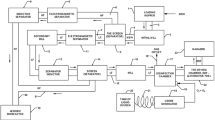Abstract
The SP-HyBRID process, which has a similar performance to commercial technologies for the decontamination of a nuclear reactor coolant system, can reduce the secondary waste generation significantly. However, the process has a problem of discharging decontamination wastewater every cycle. In this study, an improved SP-HyBRID process that can conduct the process cycles continuously without discharging decontamination wastewater every cycle was designed. It was confirmed that the improved process could be effectively applied to equipment for a decontaminating test of contaminated components, and the waste reduction can be close to 15% when compared with the existing SP-HyBRID process.








Similar content being viewed by others
References
Kim S, Park S, Cho W, Won H, Park J, Seo B (2018) Magnetic dissolution of copper catalyzed reductive decontamination. J Nucl Fuel Cycle Waste Technol 16(4):421–429
Eun H, Jung J, Park S, Park J, Chang N, Won H, Sim J, Kim S, Seo B (2019) Removal and decomposition of impurities in wastewater from the HyBRID decontamination process of the primary system in a nuclear power plant. J Nucl Fuel Cycle Waste Technol 17(4):429–435
Homonnay Z, Vertes A, Kuzmann E, Varga K, Baradlai P, Hirschberg G, Schunk J, Tilky P (2000) Effect of AP-CITROX decontamination procedure on the surface oxide layer composition of stainless steel originating from the primary circuit of a VVER-type nuclear reactor. J Radioanal Nucl Chem 246:131–136
Wood CJ (1990) A review of the application of chemical decontamination technology in the United States. Prog Nucl Energy 23(1):35–80
Bradbury D (2000) Review of decontamination technology development. Water Chemistry Nuclear Reactor System 8, BNES, London
Riess R (2009) Decontamination and steam generator chemical cleaning. Advanced Nucl. Technology International, Skultuna, Sweden
Shailaja M, Narashimhan SV (1991) Dissolution kinetics of nickel ferrite in chelating and reducing agents. J Nucl Sci Technol 28(8):748–756
van Loon LR, Hummel W (1994) The role of organics on the safety of a radioactive waste repository. Paul Scherrer Institute annual report, INIS-MF-13914
Topf C, Sempere-Belda L (2014) Aqueous, in situ primary circuit decontamination. Nucl Eng. Int 59(718):16–18
Jung JY, Eun HC, Park SY, Park JS, Chang NO, Kim SB, Seo BK, Park SJ (2018) A study on the removal of impurities in a SP-HyBRID decontamination wastewater of the primary coolant system in a pressurized water reactor. J Radioanal Nucl Chem 318:1339–1345
Choi WK, Kim SB, Yoon IH, Park JS, Won HJ, Park SY, Ahn BG, Choi MS, Choi JW, Kim SE, Yang HB, Moon JK, Jung JH (2017) Development of decommissioning, decontamination, and remediation technology for nuclear facilities: development of advanced decontamination technology for nuclear facilities. Korea Atomic Energy Research Institute Report, KAERI/RR-4230/2016, Korea
Ronie A (2019) Outokumpu HSC chemistry for windows. OutoKumpu Research, Pori
Zhang Y, Xiao S, Xie J, Yang Z, Pang P, Gao Y (2014) Simultaneous electrochemical determination of catechol and hydroquinone based on graphene-TiO2 nanocomposite modified glassy carbon electrode. Sens Actuat B Chem 204:102–108
Choudhary G, Ilansen H, Donkin S, Kirman C (1997) Toxicological Profile for Hydrazine. US Department of Health and Human Service, Agency for Toxic Substances and Disease Registry, USA
Wei W, Cui X, Chen W, Ivey DG (2009) Improved electrochemical impedance response induced by morphological and structural evolution in nanocrystalline MnO2 electrodes. Electrochim Acta 54(8):2271–2275
Goia DV, Matijevic E (1998) Preparation of mono-dispersion metal particles. New J Chem 11:1203–1215
Luo M, Yuan S, Tong M, Liao P, Xie W, Xu X (2014) An integrated catalyst of Pd supported on magnetic Fe3O4 nanoparticles: Simultaneous production of H2O2 and Fe2+ for efficient electro-Fenton degradation of organic contaminants. Water Res 48:190–199
Azatyan VV, Borisov AA (2017) Determining role of the chain mechanism of hydrazine oxidation and decomposition in kinetically controlled combustion and explosion. Kine Catal 58(4):377–383
Asgarzade S, Vahadpour M, Douroudgari H (2017) Theoretic study on the mechanism of the N2H4 plus O2 reaction on the singlet and triplet potential energy surfaces. Comput Theor Chem 1104:47–55
Poole A (2004) Treatment of biorefractory organic compounds in wool scour effluent by hydroxyl radical oxidation. Water Res 38:3458–3464
Acknowledgements
The authors would like to express their appreciation for the support provided by the National Research Foundation of Korea (NRF), which is funded by the Ministry of Science, ICT and Future Planning (MSIP) of the Republic of Korea (NRF- 2017M2A8A5015144).
Author information
Authors and Affiliations
Corresponding author
Additional information
Publisher's Note
Springer Nature remains neutral with regard to jurisdictional claims in published maps and institutional affiliations.
Rights and permissions
About this article
Cite this article
Eun, HC., Park, SY., Choi, WK. et al. A waste-minimized chemical decontamination process for the decontamination of a nuclear reactor coolant system. J Radioanal Nucl Chem 326, 665–674 (2020). https://doi.org/10.1007/s10967-020-07340-0
Received:
Published:
Issue Date:
DOI: https://doi.org/10.1007/s10967-020-07340-0




